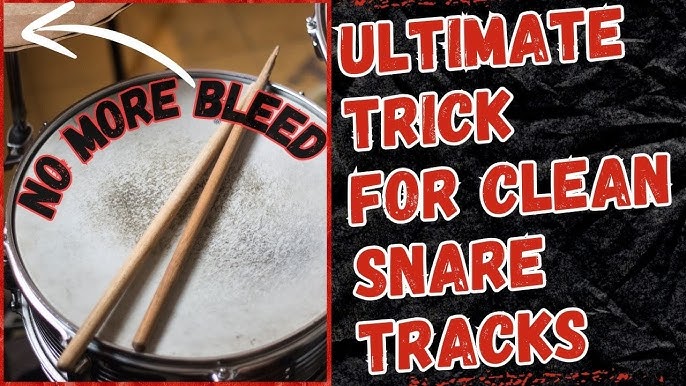Fix Snare Bleed in Minutes! Simple Mixing Hack
Blog post description.


When you're mixing drums, encountering snare bleed can feel like an inevitable frustration. The intrusive sounds of hi-hats, cymbals, or even other instruments sneaking into your snare mic can disrupt the clarity of your drum mix. But don't worry—there’s a straightforward way to clean things up and make your snare drum sound crisp and professional. In this post, we’ll walk you through a simple and effective technique to eliminate snare bleed and save your mix. Let’s dive in! 🎶
Understanding Snare Bleed: The Common Culprit
Picture this: you’ve recorded your drum tracks, and everything seemed fine during the session. But as you play it back, you’re greeted by unwanted sounds bleeding into your snare drum mic—hi-hats, cymbals, or even peculiar room noise. This happens because microphones are like ears, picking up every sound around them. In a drum setup with multiple mics, the chances of bleed are high, especially if other instruments are playing in the room during recording.
So, what’s the solution? The best approach is preparation: capturing individual drum and cymbal samples before recording begins. But what if you’re already in the mixing stage and haven’t done this? Don’t worry—there’s still hope! Let’s explore how to tackle snare bleed using a foolproof editing technique.
Step-by-Step: Fixing Snare Bleed with Tab-to-Transient
If you’re working with recorded tracks and facing snare bleed, follow these steps to clean things up:
Create a New Track: Start by creating a new mono track for your snare drum sample. You can do this by hitting Command + Shift + N (or selecting “Track” > “New” from the menu).
Selecting a Snare Hit: Use the tab-to-transient feature to locate a clean snare hit in your recording. This tool helps you pinpoint transient peaks efficiently. Make sure the tab-to-transient option (the little blue button) is enabled.
Copy and Edit: Once you’ve highlighted a clean snare drum sound, copy it. You can use shortcuts like Control + C to copy and Control + V to paste it onto the new track. Alternatively, split the section using the “B” key to isolate the hit.
Repeat the Process: Go through your snare drum track and repeat this process for every clean snare hit you need. While this might feel tedious, it’s worth the effort for a polished sound.
Compare Results: A/B test your edited snare hits against the original track to hear the difference. You’ll notice a cleaner, more focused snare sound without the distracting bleed.
Why This Technique Works
This approach allows you to isolate and enhance the snare drum while eliminating the unwanted sounds picked up by the mic. By working with clean snare samples, you can:
EQ and process the snare drum without amplifying hi-hats or cymbals.
Achieve a more professional and polished drum mix.
Maintain control and flexibility over the sound of your snare drum.
While it’s always better to record clean samples during the session, this method is a lifesaver when you’re already dealing with bleed in a mix.
Pro Tip: Record Samples Beforehand
If you want to avoid this issue altogether in future sessions, here’s a tip: before recording the full drum performance, have the drummer play individual hits on each drum and cymbal. Make sure they strike them with the same intensity as they would during the actual performance. Record these hits and let the cymbals decay fully before capturing the next one. These samples will be invaluable for editing and enhancing during the mixing phase.
Wrapping It Up
Dealing with snare bleed doesn’t have to be a nightmare. With the tab-to-transient technique and a little patience, you can achieve a clean, professional drum sound even after the recording session. This method is versatile—you can use it for toms, cymbals, or any other drum in your mix to eliminate noise and enhance clarity.
Have you tried this technique in your mixes? If not, give it a shot and let us know how it works for you. Share your experiences or any tips you have in the comments below. And don’t forget to subscribe for more mixing hacks and music production advice. Let’s make music magic together! 🌟
